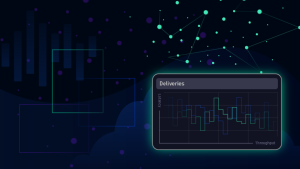
A business process is a collection of related, usually structured tasks or steps, performed in sequence, that achieve a defined business goal. Tasks may be manual or automatic, and many business processes will include a combination of both. Business processes are important because they improve the efficiency, consistency, and quality of the business outcome.
Monitoring business processes is one thing organizations can do to help improve the key business processes that enable them to provide great customer experiences. Business process monitoring refers to continuously tracking and analyzing key performance indicators (KPIs) from relevant process milestones. The goal of business process monitoring is to provide real-time visibility into the performance of a business process, including end-to-end delays so that stakeholders can quickly identify and respond to issues as they arise, and drive business outcomes that will deliver a better customer experience.
Benefits of business process monitoring
Business process monitoring enables organizations to understand how an end-to-end process is performing and pinpoint where in the process they can make improvements. Business process monitoring helps organizations:
- Increase efficiency by identifying and addressing bottlenecks or inefficiencies that may slow down a business process.
- Improve quality control by tracking KPIs and identifying areas where quality may be lacking to enable corrective action.
- Improve customer satisfaction by improving processes to provide customers with faster and higher quality service.
- Make better decisions by providing managers with real-time data about the business.
- Reduce costs. Organizations can reduce their operating costs and increase their bottom line with more efficient and better processes.
Digital transformation increases the importance – and challenges – of business process monitoring
Most organizations rely on many business processes across different departments to meet their goals and deliver outcomes to their stakeholders, whether customers, partners, or employees. As organizations continue to undergo digital transformations, more and more of their business processes are dependent on increasingly complex digital technologies. In fact, most business processes still rely on multiple systems, long ago outgrowing the capabilities of built-in platform-centric monitoring. This leaves business leaders with incomplete visibility into these critical business assets.
Approaches to achieve end-to-end visibility have met limited success, in part due to these common challenges:
- Business data is scattered across multiple systems, with inconsistent formats and different means of access. Code changes are often required to expose important business data, delaying implementation. Fragile data pipelines introduce ongoing maintenance overhead.
- Data at rest, the source for many pipelines, can be stale, often by days or longer, preventing real-time business agility.
- Business data lacks connection to the supporting IT context, limiting effective collaboration between business and IT teams. Consequences include delayed anomaly detection and missed optimization opportunities.
The results can include delayed, incomplete, and disconnected views of business process health, impacting a range of stakeholders:
- Business leaders lack real-time visibility into some of their most important assets.
- IT teams lack insight into how the systems they manage impact business outcomes.
- Customers experience product and communication delays.
- Opportunistic competitors encroach on market share.
Traditional approaches to business process monitoring must evolve to provide the end-to-end visibility, IT context, and timeliness that organizations need.
Business process monitoring examples: A retail use case
It can be helpful to put business processes in the context of a specific type of business or industry. For example, consider three common retail industry business processes that must work together efficiently to meet customer expectations:
- Inventory management to anticipate and meet dynamic customer demand
- Order processing workflow triggered by customer orders
- Order fulfillment to deliver orders to customers
Anomalies or delays anywhere in these business processes can impact customer satisfaction and revenue – yet we know these anomalies will occur.
- Without timely inventory data, business owners may be unable to respond in real time to supply chain issues or sudden shifts in customer behavior.
- Without IT context, business owners may not be able to identify the root cause of order processing failures.
- Without viewing the business process as an asset, IT teams will have little understanding of business process health, instead relying on isolated system health.
While the examples above illustrate one industry, it’s easy to see how similar processes or flows would extrapolate to other industries, such as a financial transaction workflow, applying for a loan, or booking and checking in for a trip.
How Dynatrace helps improve business process monitoring
Dynatrace business analytics helps organizations across all industries gain visibility into their business processes, overcoming many of the challenges outlined above. With Dynatrace, organizations benefit from one AI-powered data platform for unified observability, security, and business analytics, providing real-time observability for data-driven business decisions. The ability to capture business data from anywhere, whether that’s OneAgent, real user monitoring sessions, log files or external tools and data sources, simplifies access to the real-time, precise business data organizations need for better visibility into their business processes.
With access to topology metadata to automatically enrich business events, Dynatrace enables a straightforward approach to business process monitoring that goes beyond traditional methods, putting individual business process steps in context with business and IT data. Organizations can visualize an entire business process through a purpose-built Business Flow application or a custom dashboard, leveraging Davis AI for root cause analysis and Smartscape to drill down into host and process details.
Learn more about how Dynatrace helps track, analyze, and optimize business processes to increase efficiency, reduce process errors, and improve customer satisfaction in this short video.
*Salesforce customer engagement research
The post Improving customer experience with business process monitoring appeared first on Dynatrace news.
 10 months ago
43
10 months ago
43